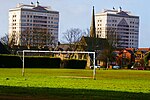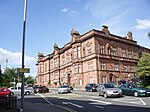Calder railway station
1866 establishments in Scotland1943 disestablishments in ScotlandCoatbridgeDisused railway stations in North LanarkshireFormer Caledonian Railway stations ... and 7 more
Pages with no open date in Infobox stationRailway stations in Great Britain closed in 1917Railway stations in Great Britain closed in 1943Railway stations in Great Britain opened in 1866Railway stations in Great Britain opened in 1919Scotland railway station stubsUse British English from August 2020
Calder railway station served the town of Coatbridge, North Lanarkshire, Scotland from 1886 to 1943 on the Rutherglen and Coatbridge Railway.
Excerpt from the Wikipedia article Calder railway station (License: CC BY-SA 3.0, Authors).Calder railway station
Kelvin Street,
Geographical coordinates (GPS) Address Nearby Places Show on map
Geographical coordinates (GPS)
| Latitude | Longitude |
|---|---|
| N 55.8569 ° | E -4.0075 ° |
Address
Kelvin Street
Kelvin Street
ML5 4QW , Carnbroe
Scotland, United Kingdom
Open on Google Maps






